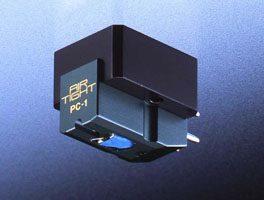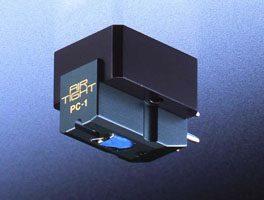


Among the brands that rarely put a foot wrong is Air Tight of Japan. In so many respects, it's as solidly recommendable as Nagra, SME or Sonus faber. Over the years, at least half a dozen Air Tight products have passed through my system, and each one drew a tear on its departure. All-valve preamps and power amps, a useful and decidedly cool passive line stage: the stuff sounds wonderful, looks great and has the sort of finish that you wish all audio components would emulate.
In January 2006, at CES, Miura-San unveiled the long-awaited PC-1 moving-coil cartridge, a microscopic embodiment of the above virtues. You could sense even before it touched the groove that it was simply gonna be right. After all, Miura-San's own track record is faultless, and it was being praised even at that early stage by a number of cartridge mavens with long experience of greats from Koetsu, Lyra, et al.
Miura-San's personal statement recounts the long gestation of the PC-1. "More than 30 years ago in my Luxman days, I had planned the MC-115C phono cartridge and asked the late Mr. Sugano, the founder of the Koetsu, to produce it on our behalf, but he was already quite old at that time, and the product therefore did not come out for a long time."
Due to a number of things, not the least being the already slow production of Koetsu's cartridges due to demand outstripping supply, followed by the death of Sugano-San himself, the delays continued but, almost miraculously, samples began to appear. Miura-San learned that a Koetsu employee named Matsudaira-San produced the design, his own resume including stints over more than two decades with Tokyo Sound (engaged in manufacture of the cartridges and tone-arms for professional broadcasting use), Entre, AudioCraft and others. According to Miura-San, "By that time, he was already an expert craftsman with full knowledge and experience."
In 2003-2004, after many years as a gun for hire, working for Koetsu, Miyabi and others, he formed My Sonic Lab, launching the Eminent high-output, low-impedance MC cartridge and the matching transformer. What appealed to Miura were Matsudaira's years of experience manifesting themselves in a design philosophy in line with Air Tight's. The resultant design is the culmination of Matsudaira's research and Miura's tweaks.
Matsudaira's own cartridges employ a proprietary high-µ magnetic core material; Miura suggested for Air Tight's version the use of wire of a slightly bigger gauge with a couple more winds, and an aluminum or boron cantilever. According to Miura, "I thought that by utilizing his epoch-making core material, an ideal design would be realized in terms of the wire material, its gauge, and the number of the winding turns, thus making it possible to achieve the ultimate target: high output and low impedance."
Their ultimate goal was 2.5 ohms internal impedance and 0.6m-volt output voltage. Miura says: "High source impedance causes considerable consumption of the generated energy in the inside of the coils, whilst small output voltage yields transmission loss to the next stages (including interconnects), thus inevitably deteriorating signal quality and increasing noise components. Nevertheless, it is mechanically and physically impossible to increment the output voltage of today's MC cartridge up to the 3m-volt-5m-volt level due to load amount imposed on the vibration system.
"In view of usual workable range of today's step-up and head-amp devices, it was considered to be reasonable to set up the output voltage at 0.5m volts-0.7m volts. But how to reduce the impedance with such output levels?"
In the PC-1, the necessary high-efficiency magnetic circuitry employs an exclusive ultra-hi-µ core material called SH-µX. It boasts "huge saturation flux density and initial permeability exceeding three times more than those of conventional cores. And it brings forth unprecedented high-efficiency magnetic characteristics, which permit a remarkable reduction in the number of coil winds, thus suppressing the inner loss down to the minimum. Its high output voltage makes it possible to reproduce an overwhelming energy sensation and extraordinary high resolution throughout whole spectrum of audio bandwidth."
Setting up the PC-1 is a breeze, thanks to its parallel sides. I started with a slightly nose-down VTA, and the cartridge settled in after a couple of months, requiring only minor adjusting so that the eventual, post-run-in stance was a top plate parallel to the disc. This applied to both the SME and Trio arms. Tracking in both was spot-on at 2.1g, and I set the anti-skate slightly low. While Air Tight has its own head amps, I simply used my references, the AudioValve Sunilda and the Audio Research PH5.
Here's where the fun began: I couldn't find an impedance setting that suited the cartridge in every case. Fortunately, unlike fixed value step-ups or those requiring internal changes, both phono amps allow easy value changes - the ARC's is accessible via remote. So, depending on the system, I found myself using both 47k-ohm and 100-ohm settings and, on one or two occasions, 500 ohms. However, this is NOT a value judgment. It has no bearing on quality; it's merely an observation that knob twiddlers can have a lot of fun.
Although the PC-1 sounded great from the very instant it touched the first LP - a mint copy of Johnny Horton's Greatest Hits - the cartridge loosened up over the course of half a dozen or so discs. Although I continually monitored the VTA, this cartridge is also incredibly forgiving. Yes, the hardcore set-up fetishists can go all the way with laser devices and anything else in their arsenals. But take it from me: masochism is not a prerequisite for ownership.
Once you're happy with it - both physical set-up and head amp settings - the cartridge first displays its prowess with such speed and attack that even Decca devotees will be impressed. Note, though, that speed is the main thing about this cartridge that is Decca-like. In nearly every other area, it's classic moving-coil, with lushness and lower registers that identify strands of Koetsu in its DNA. This is a cartridge for the music lover, especially one who adores 1950s vinyl, Capitol sessions, smoky vocals, acoustic bass and harmony groups. But the choice of Johnny Horton was fortuitous: the space and percussion have always proved a challenge. The Air Tight slid through it with ease, building up a massive soundstage and some of the best decay I've ever experienced.
Following that with some Hi-Lo's LPs (mono, no less), I found a silkiness reminiscent of the original Koetsu Urushi, and detail that recalled the London Reference. It even finds layers in mono! You can put this to good use with Nat King Cole or Dean Martin recordings of 1950s Capitol vintage; the synergy with orchestral arrangements from that hit factory means a steady flow of seamless, room-filling bliss. Indeed, every LP I played sounded particularly lifelike when it came to scale and especially stage depth.
Hard rock and funk, from the Georgia Satellites to George Clinton, revealed a tiny trace of sluggishness at the bottom end, but that could also seem a blessing: at no point, even with James Brown remixes, was the sound too aggressive. The top end, on the other hand, is as fast as can be; as I mentioned before, it's Decca-like. So, if you adore crisp percussion, fast guitar work and sharp trumpet bursts, this MC could be your ticket to paradise.
There is, however, a sting in the tail. I'm finding it harder and harder to understand cartridge pricing. When I see what goes inside a cartridge, and then consider what £3895 will buy you from IWC or Breitling, I need to check my pulse. Maybe I was wrong: perhaps fiscal masochism is a prerequisite? Whatever, if you have the cash, the Air Tight PC-1 is one of the sweetest cartridges money can buy.